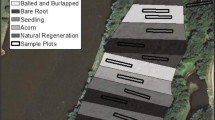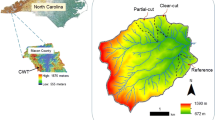Abstract
In 1939, an experiment was established on the Jornada Experimental Range to evaluate the effects of shrub removal, rabbit exclusion, furrowing, and seeding in creosotebush [Larrea tridentata (DC.) Cov] vegetation. Sixteen plots (21.3×21.3 m) were laid out in four rows of four plots per row with a buffer zone of 7.6 m between plots and rows. A barbed wire fence excluded cattle and poultry wire fencing excluded lagomorphs. Treatments were factorially applied at two levels. Plant cover in the plots was sampled in 1938 (before treatment), 1947, 1956, 1960, 1967 and 1989 with randomly located, line-intercept transects. Data from all sampling dates were analyzed as a split plot in time and main effects for 1989 tested by analysis of variance for a 2×4 factorial experiment. There were significant (P<0.10) year x treatment interactions. Seeding and furrowing treatments were ineffective but lagomorph exclusion and shrub clearing treatments resulted in significant treatment differences for several species. In 1989, basal area of spike dropseed (Sporobolus contractus A.S. Hitchc.) was 30-fold greater on the lagomorph excluded than on the lagomorph unexcluded treatment. Canopy cover of honey mesquite (Prosopis glandulosa Torr. var. glandulosa), tarbush (Flourensia cernua DC.) and mariola (Parthenium incanum H.B.K.) were affected by lagomorph exclusion. None of the responses were viewed as successional in nature. They principally represented individual species sensitivities to either absence of a primary herbivore or removal of aboveground shrub biomass. Though the physical treatments could be regarded as relatively severe disturbances of the system, the impacts on community vegetation dynamics were relatively insignificant.
Similar content being viewed by others
References
Bear GD, Hansen RM (1966) Food habits, growth and reproduction of white-tailed jackrabbits in southern Colorado. Colorado State Univ Agr Exp Sta Tech Bull 90, Ft Collins
Beck RF, Tober DA (1985) Vegetation changes on creosotebush sites after removal of shrubs, cattle and rabbits. New Mexico State Univ Agr Exp Sta Bull 717
Brown HL (1947) Coaction of jackrabbits, cottontails, and vegetation in mixed prairie. Trans Kans Acad Sci 50:28–44
Brown JH, Heske EJ (1990) Control of a desert-grassland transition by a keystone rodent guild. Science 250:1705–1707
Buffington LC, Herbel CH (1965) Vegetational changes on a semidesert grassland range from 1858 to 1963. Ecol Monogr 35:139–164
Chew RM, Chew AE (1970) Energy relationships of the mammals of a desert shrub (Larrea tridentata) community. Ecol Monogr 40:1–21
Currie PO, Goodwin DL (1966) Consumption of forage by blacktailed jackrabbits on salt-desert ranges of Utah. J Wildl Manage 30:304–311
Dabo SM, Pieper RD, Beck RF, Southward GM (1982) Summer and fall diets of blacktailed jackrabbits on semidesert rangeland. New Mexico State Univ, Agr Exp Sta. Res Report 476
Fagerstone KA, Lavoie FK, Griffith RE Jr (1980) Black-tailed jackrabbit diet and density on rangeland and near agricultural crops. J Range Manage 33:229–233
Fatehi M (1986) Comparative seasonal food habits of black-tailed jackrabbits and cattle on semi-desert rangeland. PhD Diss New Mexico State Univ, Las Cruces
Friedel MH (1991) Range condition assessment and the concept of thresholds: a viewpoint. J Range Manage 44:422–426
Hall ER, Kelson KR (1959) The mammals of North America. Ronald Press Co, New York vol 1
Hansen RM, Flinders JT (1969) Food habits of North American hares. Science Series No 1 Range Science Dept, Colorado State Univ, Ft Collins
Hayden P (1966) Food habits of black-tailed jackrabbits in southern Nevada. J Mammal 47:42–46
Herbel CH, Ares FN, Wright RA (1972) Drought effects on a semidesert grassland range. Ecology 53:1084–1093
Johnson RD, Anderson JE (1984) Diets of black-tailed jackrabbits in relation to population density and vegetation. J Range Manage 37:79–83
Korzdorfer EJ (1968) Seeding, furrowing, brush removal, and rabbit exclusion effects on creasotebush-infested sites. MS Thesis New Mexico State Univ, Las Cruces
Laycock WA (1991) Stable states and thresholds of range conditions on North American rangelands. J Range Manage 44:427–433
Meyer MW, Karasov WH (1991) Chemical aspects of herbivory in arid and semiarid habitats. In: Palo RT Robbins CT (eds) Plant defences against mammalian herbivory. CRC Press, Inc. Boston
Neher RE, Bailey OF (1976) Soil survey of White Sands Missile Range, New Mexico. USDA Soil Conservation Service, US Dept Army, and New Mexico Agr Exp Sta
Nelson EW (1934) The influence of precipitation and grazing upon black grama. New Mexico Agr Expt Sta Press Bul 409
Norris JJ (1950) Effect of rodents, rabbits, and cattle on two vegetation types in semidesert range land. New Mexico State Univ Agr Exp Sta Bull 353
Noy-Meir I (1973) Desert ecosystems: environment and producers. Ann Rev Ecol Syst 4:25–51
Paulsen HAJr, Ares FN (1962) Grazing values and management of black grama and tobosa grasslands and associated shrub ranges of the Southwest. USDA Forest Service Tech Bull no 1270
Riegel A (1942) Some observations of the food coactions of rabbits in western Kansas during periods of stress. Trans Kans Acad Sci 45:369–375
Schlesinger WH, Reynolds JF, Cunningham GL, Huenneke LF, Jarrell WM, Virginia RA, Whitford WG (1990) Biological feedbacks in global desertification. Science 247:1043–1048
Schneberger A (1990) Botanical diets and dietary overlap of blacktailed jackrabbits and cattle on black grama grassland. MS Thesis New Mexico State Univ, Las Cruces
Sparks DR (1968) Diets of black-tailed jackrabbits on sanhill rangeland in Colorado. J Range Manage 21:203–208
Statistical Analysis System (1990) SAS User's Guide SAS Institute Inc Cary, NC
Steinberger Y, Whitford WG (1983) The contribution of shrub pruning by jackrabbits to litter input in a Chihuahuan Desert ecosystem. J Arid Environ 6:183–187
Uresk DW (1978) Diets of the black-tailed hare in steppe vegetation. J Range Manage 31:439–442
Vorhies CT, Taylor WP (1933) The life histories and ecology of jackrabbits, Lepus alleni and Lepus californicus ssp. in relation to grazing in Arizona. Arizona State Univ Agr Exp Sta Tech Bull 49:471–587
Wansi T (1989) Botanical content of blacktailed jackrabbit diets on semi-desert rangeland. MS Thesis New Mexico State Univ, Las Cruces
Westoby M (1980) Black-tailed jackrabbit diets in Curlew Valley, northern Utah. J Wildl Manage 44:942–948
Westoby M, Walker B, Noy-Meir I (1989) Oportunistic management for rangelands not at equilibrium. J Range Manage 43:266–274
Author information
Authors and Affiliations
Rights and permissions
About this article
Cite this article
Gibbens, R.P., Havstad, K.M., Billheimer, D.D. et al. Creosotebush vegetation after 50 years of lagomorph exclusion. Oecologia 94, 210–217 (1993). https://doi.org/10.1007/BF00341319
Received:
Accepted:
Issue Date:
DOI: https://doi.org/10.1007/BF00341319




